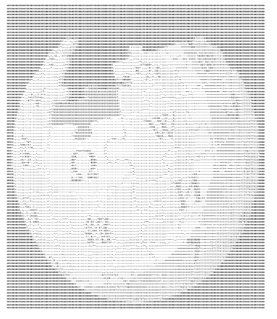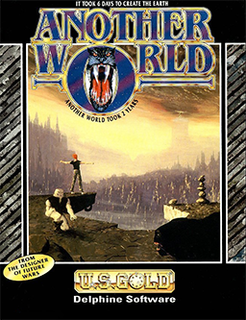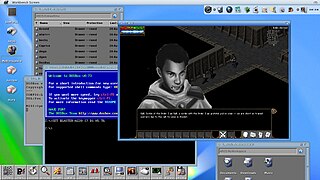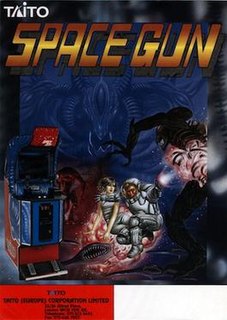Related Research Articles

ASCII art is a graphic design technique that uses computers for presentation and consists of pictures pieced together from the 95 printable characters defined by the ASCII Standard from 1963 and ASCII compliant character sets with proprietary extended characters. The term is also loosely used to refer to text based visual art in general. ASCII art can be created with any text editor, and is often used with free-form languages. Most examples of ASCII art require a fixed-width font such as Courier for presentation.

The Amiga is a family of personal computers introduced by Commodore in 1985. The original model was one of a number of 16/32- and 32-bit computers that featured 256 KB or more of RAM, mouse-based GUIs, and significantly improved graphics and audio over 8-bit systems. This wave included the Atari ST—released the same year—Apple's Macintosh, and later the Apple IIGS. Based on the Motorola 68000 microprocessor, the Amiga differed from its contemporaries through the inclusion of custom hardware to accelerate graphics and sound, including sprites and a blitter, and a pre-emptive multitasking operating system called AmigaOS.
The Guru Meditation is an error notice displayed by the Commodore Amiga computer when they crashed. It is analogous to the "Blue Screen of Death" in Microsoft Windows operating systems, or a kernel panic in Unix. It has later been used as a message for unrecoverable errors in software such as Varnish and VirtualBox.

The Motorola 68060 ("sixty-eight-oh-sixty") is a 32-bit microprocessor from Motorola released in 1994. It is the successor to the Motorola 68040 and is the highest performing member of the 68000 series. Two derivatives were produced, the 68LC060 and the 68EC060.
Speech synthesis is the artificial production of human speech. A computer system used for this purpose is called a speech computer or speech synthesizer, and can be implemented in software or hardware products. A text-to-speech (TTS) system converts normal language text into speech; other systems render symbolic linguistic representations like phonetic transcriptions into speech.
A taskbar is an element of a graphical user interface which has various purposes. It typically shows which programs are currently running.

Another World, known as Out of This World in North America, is a 1991 cinematic platformer action-adventure game designed by Éric Chahi and published by Delphine Software. The game tells a story of Lester, a young scientist who, as a result of an experiment gone wrong, finds himself on a dangerous alien world where he is forced to fight for his survival.

Google Ads is an online advertising platform developed by Google, where advertisers bid to display brief advertisements, service offerings, product listings, or videos to web users. It can place ads both in the results of search engines like Google Search and on non-search websites, mobile apps, and videos. Services are offered under a pay-per-click (PPC) pricing model.

Mercenary is the first in a series of computer games, published on a number of 8-bit and 16-bit platforms from the mid-1980s to the early 1990s, by Novagen Software. The second and third games were known as Damocles and Mercenary III: The Dion Crisis respectively.

Jinxter is an interactive fiction video game developed by Magnetic Scrolls and published by Rainbird in 1987 for 8-bit and 16-bit home computers of the time. Jinxter tells the story of a man on a mission to save the fictional land of Aquitania from the looming threat of evil witches. The game was well received by critics upon its release.

The Three Stooges is a video game released by Cinemaware in 1987 for the Amiga based on the comedy act of the same name. In the game, players control Stooges Moe, Larry and Curly in minigames based on classic Stooges films with the aim of raising enough money to save an orphanage. The game was later ported for different systems including the Apple IIGS, Commodore 64, NES and Game Boy Advance. While the game has been praised as a faithful adaptation of the Stooges films, it has been criticized for repetitive gameplay and limited replay value.

Universe is a graphic adventure game developed and published by Core Design for the Amiga, Amiga CD32 and DOS platforms in 1994. It was Core Design's second and last effort in the adventure game genre after Curse of Enchantia, of which it was originally planned to be a sequel.

Curse of Enchantia is a graphic adventure game developed and released by the British video game company Core Design for MS-DOS and the Amiga in 1992. The game tells the comic fantasy story of Brad, a teenage boy from modern Earth who was magically abducted to the world of Enchantia by an evil witch-queen. Brad needs to escape and take on the forces of darkness to find a way back to his own dimension.

AmigaOS 4 is a line of Amiga operating systems which runs on PowerPC microprocessors. It is mainly based on AmigaOS 3.1 source code developed by Commodore, and partially on version 3.9 developed by Haage & Partner. "The Final Update" was released on 24 December 2006 after five years of development by the Belgian company Hyperion Entertainment under license from Amiga, Inc. for AmigaOne registered users.

AROS Research Operating System is a free and open-source multi media centric implementation of the AmigaOS 3.1 APIs. Designed to be portable and flexible, ports are currently available for x86-based and PowerPC-based PCs in native and hosted flavors, with other architectures in development. AROS, in a show of full circle, was also ported to the m68k-based Amiga 1200, and there is also an ARM port for the Raspberry Pi series.

Space Gun is a 1990 first-person shooter arcade game released by Taito. The game is set aboard a crippled space station that has been overrun by hostile alien creatures. The objective is to rescue human crew members while destroying the alien creatures. The game lets the player shoot limbs off the creatures, resulting in blood splatters.

AmigaOS is a family of proprietary native operating systems of the Amiga and AmigaOne personal computers. It was developed first by Commodore International and introduced with the launch of the first Amiga, the Amiga 1000, in 1985. Early versions of AmigaOS required the Motorola 68000 series of 16-bit and 32-bit microprocessors. Later versions were developed by Haage & Partner and then Hyperion Entertainment. A PowerPC microprocessor is required for the most recent release, AmigaOS 4.

AmigaOne X1000 is a PowerPC-based personal computer intended as a high-end platform for AmigaOS 4. It was announced by A-Eon Technology CVBA in partnership with Hyperion Entertainment. Its name pays homage to the Amiga 1000 released by Commodore in 1985. It is, however, not hardware compatible with the original Commodore Amiga system.
References
- 1 2 3 4 "KindWords". PC Museum. Archived from the original on 2011-07-21. Retrieved 2011-06-05.
- 1 2 "KindWords 3". The Centre for Computing History . Retrieved 2011-06-05.